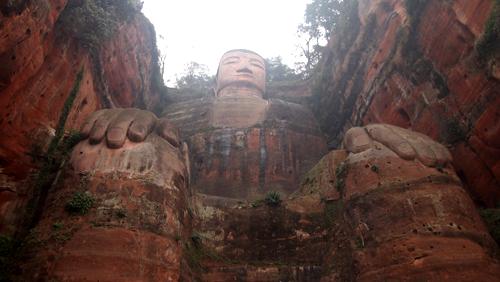|
The Leshan
Giant Buddha
The Leshan Giant Buddha is situated on the west
side of the Xiluan Peak (Phoenix-Perched Peak) of Mt. Lingyun,
overlooking the confluence of the Mingjiang, Dadhue and Qingyijiang
rivers. Around it you will find a huge cultural treasure trove. The
Mahoa Cliff Tombs disclose a myriad of unearthed antiques which date
back nearly two thousand years ago. Moreover, you will be fascinated
by scenic spots such as Nine-Turn Plank Walkway, Lingyun Temple,
Lingbao Pagoda (Deity Pagoda), Dongpo Pavilion, and Giant Sleeping
Buddha.
 To the right of the Giant Buddha is a
precipitous passageway, with 250 steps downward, which zigzags with
nine turns. This is the famous Nine-Turn Plank walkway. As you
descend it, you may be overwhelmed with dizziness, feeling as if you
perched on a perilous abyss. At the top of the cliff, level with the
head of the Giant Buddha is a veranda where tourists may relax.
Alongside the paths of the cliffs are enshrined two notable
statuettes, engraved during the Tang Dynasty and still intact, the
best examples among thousands of statuettes on both sides. To the right of the Giant Buddha is a
precipitous passageway, with 250 steps downward, which zigzags with
nine turns. This is the famous Nine-Turn Plank walkway. As you
descend it, you may be overwhelmed with dizziness, feeling as if you
perched on a perilous abyss. At the top of the cliff, level with the
head of the Giant Buddha is a veranda where tourists may relax.
Alongside the paths of the cliffs are enshrined two notable
statuettes, engraved during the Tang Dynasty and still intact, the
best examples among thousands of statuettes on both sides.
Mt. Lingyun is no more than 140 meters high,
but it is the highest among the nine peaks of the mountains. Lingyun
Temple on the Xiluan Peak and the Lingbao Pagoda on the Lingbao Peak
are the only remaining structures on the nine peaks. Lingyun Temple
is a complex on a grand scale, not far from which stands the Giant
Buddha. From the cliff nearby you can see every detail of the Giant
Buddha’s head. Since the Giant Buddha is located in front of the
Lingyun Temple, it is also called Giant Lingyun Buddha. The temple
is otherwise named Giant Buddha Temple because of its proximity to
the Giant Buddha.
Dongpo Pavilion, a two-story wooden structure,
another scenic sight at the Xiluan Peak, is behind the statue, and
named after the celebrated poet Su Shi, who went by the pen-name of
Su Dongpo. In front of the pavilion lies a pool, called the
Ink-Washing Pool, where Dongpo supposedly washed his writing
brushes. Adjacent to Lingyun Temple stands Mt, Wuyou, which is
connected to Mt. Lingyun by a cable suspension bridge over a brook;
this is an indispensable link to the entire area. Wuyou Temple,
standing on Mt. Wuyou, was designed to conform to the rolling
terrain in an exquisite style. The Deity Pagoda is so named because
of its location on Deity Peak, one of the nine peaks of Mt. Lingyun.
It is also commonly known as the White Pagoda and Sakyamuni Sarira
Pagoda. Ascending to the top of the pagoda, tourists can view the
surging rivers, the west part of Mt. Emei, and the skyline of Leshan
City proper. celebrated poet Su Shi, who went by the pen-name of
Su Dongpo. In front of the pavilion lies a pool, called the
Ink-Washing Pool, where Dongpo supposedly washed his writing
brushes. Adjacent to Lingyun Temple stands Mt, Wuyou, which is
connected to Mt. Lingyun by a cable suspension bridge over a brook;
this is an indispensable link to the entire area. Wuyou Temple,
standing on Mt. Wuyou, was designed to conform to the rolling
terrain in an exquisite style. The Deity Pagoda is so named because
of its location on Deity Peak, one of the nine peaks of Mt. Lingyun.
It is also commonly known as the White Pagoda and Sakyamuni Sarira
Pagoda. Ascending to the top of the pagoda, tourists can view the
surging rivers, the west part of Mt. Emei, and the skyline of Leshan
City proper.
Giant Sleeping Buddha is acclaimed as a
marvelous spectacle, made up of the contours of Mt. Wuyou, Mt.
Lingyun, and Mt. Guicheng (Tortoise City Mountain). The Giant Buddha
lies asleep on the east bank of the Minjiang River, extending
roughly 1,300 meters with its head to the south and its feet to the
north. Observed from a distance from the opposite bank, Leshan Giant
Buddha is appropriately seated in the bosom of Giant Sleeping
Buddha, presenting a miracle of the “Buddha existing within a
Buddha”. As an integral part of the scenery of Leshan, it conveys to
tourists both aesthetic perceptions and religious sentiments of the
Chinese Buddhist culture.
HOW TO TOUR LESHAN GIANT BUDDHA
Tour Leshan with Great Wall Adventure Club, the best
Chengdu
tour agent to help
you with your hotel booking and transfers.
|

